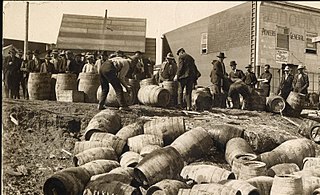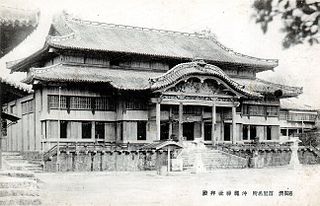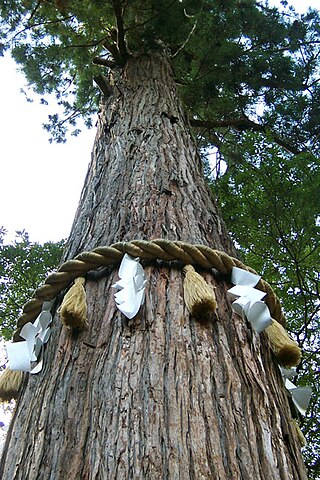
Prohibition is the act or practice of forbidding something by law; more particularly the term refers to the banning of the manufacture, storage, transportation, sale, possession, and consumption of alcoholic beverages. The word is also used to refer to a period of time during which such bans are enforced.

Cockfighting is a blood sport involving roosters ("cocks"), held in a ring called a cockpit. The first documented use of the word gamecock, denoting use of the cock as to a "game", a sport, pastime or entertainment, was recorded in 1634, after the term "cock of the game" used by George Wilson, in the earliest known book on the sport of cockfighting in The Commendation of Cocks and Cock Fighting in 1607. But it was during Magellan's voyage of discovery of the Philippines in 1521 when modern cockfighting was first witnessed and documented for Westerners by the Italian Antonio Pigafetta, Magellan's chronicler, in the Kingdom of Taytay.

Hiroshima Prefecture is a prefecture of Japan located in the Chūgoku region of Honshu. Hiroshima Prefecture has a population of 2,811,410 and has a geographic area of 8,479 km². Hiroshima Prefecture borders Okayama Prefecture to the east, Tottori Prefecture to the northeast, Shimane Prefecture to the north, and Yamaguchi Prefecture to the southwest.

Hatsukaichi is a city located in Hiroshima Prefecture, Japan. As of 1 May 2023, the city had an estimated population of 116,087 in 53320 households and a population density of 240 persons per km². The total area of the city is 489.48 square kilometres (188.99 sq mi).

Itsukushima Shrine is a Shinto shrine on the island of Itsukushima, best known for its "floating" torii. It is in the city of Hatsukaichi, in Hiroshima Prefecture in Japan, accessible from the mainland by ferry at Miyajimaguchi Station. The shrine complex is listed as a UNESCO World Heritage Site, and the Japanese government has designated several buildings and possessions as National Treasures.

A Shinto shrine is a structure whose main purpose is to house ("enshrine") one or more kami, the deities of the Shinto religion.

Itsukushima (厳島) is an island in the western part of the Inland Sea of Japan, located in the northwest of Hiroshima Bay. It is popularly known as Miyajima (宮島), which in Japanese means "Shrine Island". The island is one of Hayashi Gahō's Three Views of Japan specified in 1643. Itsukushima is part of the city of Hatsukaichi in Hiroshima Prefecture. The island was part of the former town of Miyajima before the 2005 merger with Hatsukaichi.

A National Treasure is the most precious of Japan's Tangible Cultural Properties, as determined and designated by the Agency for Cultural Affairs. A Tangible Cultural Property is considered to be of historic or artistic value, classified either as "buildings and structures" or as "fine arts and crafts". Each National Treasure must show outstanding workmanship, a high value for world cultural history, or exceptional value for scholarship.

The 1555 Battle of Miyajima was the only battle to be fought on the sacred island of Miyajima; the entire island is considered to be a Shinto shrine, and no birth or death is allowed on the island. Extensive purification rituals took place after the battle, to cleanse the shrine and the island of the pollution of death.

Munakata Taisha (宗像大社) is a collection of three Shinto shrines located in Munakata, Fukuoka Prefecture, Japan. It is the head of the approximately 6,000 Munakata shrines all over the country. Although the name Munakata Taisha refers to all three shrines—Hetsu-gū, Nakatsu-gū and Okitsu-gū—it is commonly used to refer to Hetsu-gū alone. As documented in Japan's second oldest book, Nihon Shoki, the shrines are devoted to the three Munakata goddesses.

Harry Cornwall Wheeler was an Arizona lawman who was the third captain of the Arizona Rangers, as well as the sheriff of Cochise County, serving from 1912 into 1918. He is known as the lead figure in the illegal mass kidnapping and deportation of some 1200 miners and family members, many of them immigrants, from Bisbee, Arizona to New Mexico in 1917. Beginning on July 12, 1917, he took total control of the town of Bisbee, controlling access and running kangaroo courts that deported numerous people.

Shinto architecture is the architecture of Japanese Shinto shrines.

The term shinbutsu kakuri in Japanese Buddhist terminogy refers to the tendency in medieval and early modern Japan to keep some kami separate from Buddhism. While some kami were integrated in Buddhism, others were kept systematically away from Buddhism. This phenomenon had significant consequences for Japanese culture as a whole. It should not be confused with shinbutsu bunri or with haibutsu kishaku, which are phenomenons recurrent in Japanese history and usually due to political causes. While the first assumes the acceptance of Buddhism, the second and third actually oppose it.

Alcohol laws are laws relating to manufacture, use, being under the influence of and sale of alcohol or alcoholic beverages. Common alcoholic beverages include beer, wine, (hard) cider, and distilled spirits. Definition of alcoholic beverage varies internationally, e.g., the United States defines an alcoholic beverage as "any beverage in liquid form which contains not less than one-half of one percent of alcohol by volume". Alcohol laws can restrict those who can produce alcohol, those who can buy it, when one can buy it, labelling and advertising, the types of alcoholic beverage that can be sold, where one can consume it, what activities are prohibited while intoxicated, and where one can buy it. In some cases, laws have even prohibited the use and sale of alcohol entirely.
The Shinto Directive was an order issued in 1945 to the Japanese government by Occupation authorities to abolish state support for the Shinto religion. This unofficial "State Shinto" was thought by Allies to have been a major contributor to Japan's nationalistic and militant culture that led to World War II. The purpose of the directive was ostensibly based in ideas of freedom of religion and separation of church and state.

Until the Meiji period (1868–1912), the jingū-ji were places of worship composed of a Buddhist temple and a Shintō shrine, both dedicated to a local kami. These complexes were born when a temple was erected next to a shrine to help its kami with its karmic problems. At the time, kami were thought to be also subjected to karma, and therefore in need of a salvation only Buddhism could provide. Having first appeared during the Nara period (710–794), jingū-ji remained common for over a millennium until, with few exceptions, they were destroyed in compliance with the Kami and Buddhas Separation Act of 1868. Seiganto-ji is a Tendai temple part of the Kumano Sanzan Shinto shrine complex, and as such can be considered one of the few shrine-temples still extant.
Women occupy a unique role in the indigenous Japanese traditions of Shinto, including a unique form of participation as temple stewards and shamans, or miko. Though a ban on female Shinto priests was lifted during World War II, the number of women priests in Shinto is a small fraction of contemporary clergy.

Okinawa Shrine is a Shinto shrine in Naha, Okinawa Prefecture, Japan. Established at the end of the Taishō period on the site of Shuri Castle, the main hall of which was reused as the haiden, the shrine buildings were destroyed in May 1945 during the Battle of Okinawa. Both castle and shrine have since been rebuilt while this phase has been written out of the "official history" currently told at Shurijō Castle Park.

A shinboku (神木) is a tree or forest worshipped as a shintai – a physical object of worship at or near a Shinto shrine, worshipped as a repository in which spirits or kami reside. They are often distinctly visible due to the shimenawa wrapped around them.
Nyonin Kinsei (女人禁制) is a general term for a type of society custom against women that is found in Japan.

















